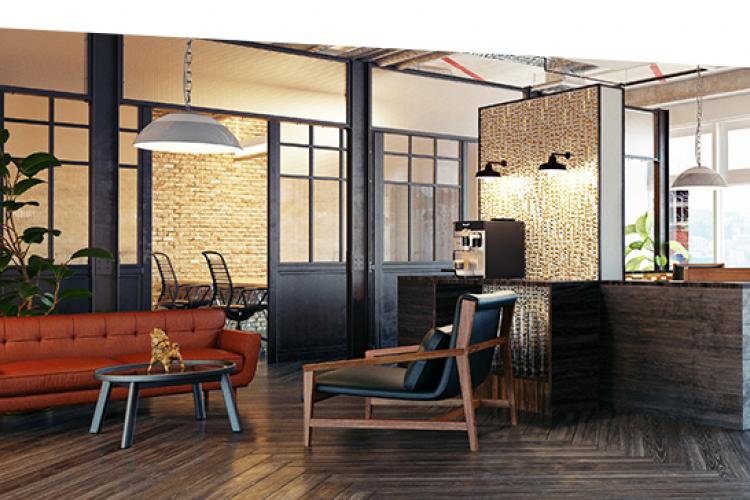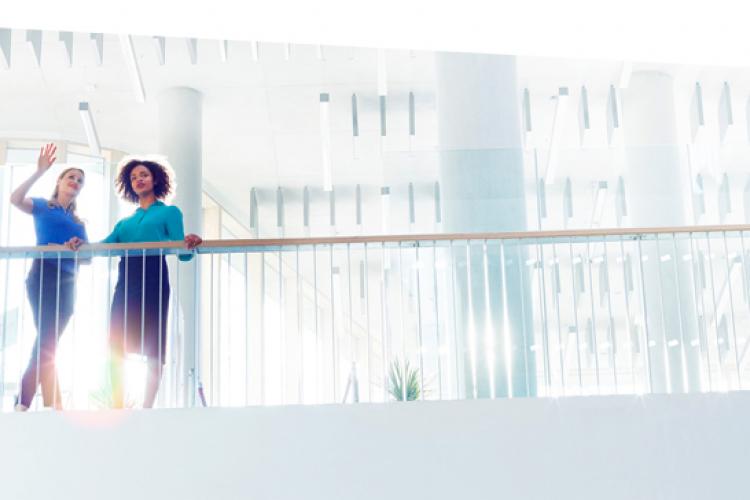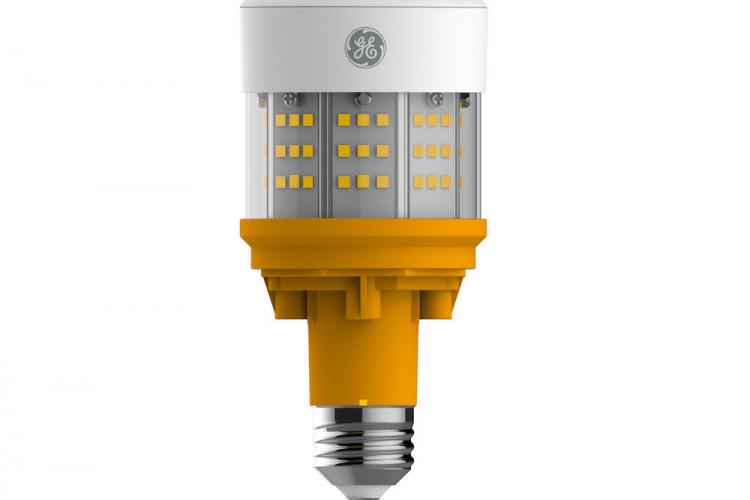Whitepaper: IoT Activation 101: Bringing Data Intelligence to Every Corner of Your Building
Whitepaper: IoT Activation 101: Bringing Data Intelligence to Every Corner of Your Building
Internet of Things (IoT) platforms supported by LED lighting arrangements can bring incredible benefits to commercial buildings, from compelling energy savings to amazing possibilities enabled by connected infrastructure. Welcome to a world where lighting is efficient, intelligent and, above all, adaptable to your digital transformation journey.
FROM LED TO IoT
Worldwide spending on IoT technologies will reach $1.2 trillion by 2022, reports International Data Corporation (IDC). IDC notes the diverse IoT market is at a turning point where projects are moving from proof of concept to commercial deployments. As organizations look to scale their investments, spending for IoT-enabled hardware, software, services and connectivity solutions will experience a compound annual growth rate of nearly 14%.
Digital transformation is happening across all industries as companies embrace emerging technologies aimed at elevating their people, processes and products. As the IoT market reaches critical mass, enterprises are merging their physical and digital realities to unlock new operational efficiencies and business outcomes.
One digital technology stands apart for real estate and facility managers who want to create commercial building spaces that both inspire people and prevent wasteful spending. LED lighting is proven to significantly reduce energy costs compared to conventional light sources, and now—as a platform for data capture and exchange—LED is enabling digital ceilings that support endless possibilities.
Lighting is ubiquitous throughout all buildings, and LED fixtures, having their own power source, can be equipped with sensors to harvest an array of data that can become the foundation for better business decisions, smarter space utilization and streamlined operations.
No other asset rivals the potential of LED lighting to dramatically transform the way people experience office environments while drastically reducing electricity use. From LED to IoT, smart buildings start with the flip of a switch.
FOUR BIG BENEFITS
Intelligent LEDs allow for amazing possibilities in commercial office buildings:
1. EDGE ANALYTICS: LED light fixtures leveraging onboard electronic devices can power an all-sensing, data-compiling network operating at the edge where IT and operational technology (OT) collide.
2. EFFICIENCY MASTERED: A building automation system that integrates data from connected fixtures becomes even more responsive, creating long-term HVAC and lighting energy savings.
3. PRODUCTIVITY PLUS: As an open platform for innovation, smart lighting networks can support limitless software and services opportunities, resulting in greater efficiency.
4. HOLISTIC VIEW: At the highest level, intelligent LEDs help provide enterprisewide visibility into the health and performance of commercial buildings.
Employees who are satisfied with their workplace are
16% MORE PRODUCTIVE | 18% MORE LIKELY TO STAY | 30% MORE ATTRACTED
to the company over competitors.
> Gartner Research as reported by Ladders, Inc.
START HERE
Take the first step on your journey from LED to IoT with a free lighting audit. You will discover what needs to be replaced, what is smart to keep and how much you could save in energy.

GROUND FLOOR:
Get on Board With LED
LEDs are bringing new energy to existing spaces and are increasingly the choice for all new construction. At the same time, LED light fixtures are becoming the foundation of future intelligent buildings.
Leveraging lighting as a communication hub to HVAC, security and other building systems creates IoT opportunities in every corner of the office. The pervasive nature of lighting makes it the ideal platform for connected possibilities by ensuring data never has far to travel.
No matter your lighting need, there’s an LED option that’s perfectly suited for any office.
LED Tubes are a direct replacement for traditional T8 and T5 linear fluorescent lamps and use 43%-53% LESS ENERGY ON AVERAGE.
SUSPENDED INDOOR FIXTURES that bring style and savings to any work or living space.
RECESSED INDOOR LIGHTING for replacing outdated fluorescent fixtures in offices, banks and buildings of all types.
OUTDOOR AREA LIGHTS for brightly illuminating pathways and parking lots while saving big on your utility bill compared to HID alternatives.
WALL-MOUNTED LUMINAIRES that enhance the security of any building.
UNPARALLELED ADVANTAGES
LED technology offers three crucial advantages in commercial buildings:
 UNMATCHED EFFICIENCY: While it varies by application, LEDs typically consume 50% less electricity than traditional light sources.
UNMATCHED EFFICIENCY: While it varies by application, LEDs typically consume 50% less electricity than traditional light sources.
 UNRIVALED OPTICS: LEDs can aim light where it is needed, provide high uniformity with low glare and are available in a variety of color temperatures.
UNRIVALED OPTICS: LEDs can aim light where it is needed, provide high uniformity with low glare and are available in a variety of color temperatures.
 UNBEATABLE LIFE: LEDs do not burn out—they slowly dim or deteriorate over a long period of time (10 years or more in many cases).
UNBEATABLE LIFE: LEDs do not burn out—they slowly dim or deteriorate over a long period of time (10 years or more in many cases).
NO ORDINARY LAMP
LEDs are semiconductor light sources also known as solid-state lighting (SSL) devices. Unlike conventional lamps, LEDs do not use electrical filaments, plasmas or gases to create light. This makes them well-suited for hosting sensitive onboard electronics, including controls, transmitters, sensors and other hardware.
YOU’RE IN CONTROL
LEDs are highly controllable, giving commercial property managers more options to save energy and improve the working environment. Standard lighting control system features include:
 DIMMING: Dimming controls lower the light output of a source, usually by reducing the wattage it is being operated at. This is an increasingly popular energy-conserving strategy.
DIMMING: Dimming controls lower the light output of a source, usually by reducing the wattage it is being operated at. This is an increasingly popular energy-conserving strategy.
 SCHEDULING: Scheduling controls allow lights to be automatically switched on or off at different times of the day, saving building supervisors the time and trouble.
SCHEDULING: Scheduling controls allow lights to be automatically switched on or off at different times of the day, saving building supervisors the time and trouble.
 OCCUPANCY SENSING: Occupancy sensors go a step beyond scheduling by detecting motion within a space and switching lights on or off as needed, making them a preferred lighting control solution.
OCCUPANCY SENSING: Occupancy sensors go a step beyond scheduling by detecting motion within a space and switching lights on or off as needed, making them a preferred lighting control solution.
CALCULATE YOUR SAVINGS
The Lighting Energy Estimator from GE Current, a Daintree company, shows you just how much an LED relamping project could save—it only takes a minute to compare your current system.

SECOND FLOOR:
Add Advanced Control
Taking control of your LED lighting deployment is the next step to building intelligence across your property portfolio. Lighting controls—offering everything from simple dimming to fully integrated IoT capabilities—can slash energy use up to 30% on top of the savings already delivered by LEDs, all while making it much easier to create comfortable, inviting spaces.
Critically, today’s systems can put control in the user’s hands, allowing employees to tailor light levels to individual workstations or to suit certain tasks. Small Business Trends notes how recent studies have revealed a significant connection between office lighting and employee productivity. The digital magazine cites a survey by The American Society of Interior Design that found 68% of employees have expressed discontent with their office lighting. Indeed, quality illumination is important for reducing stress levels, improving work output and creating happier associates.
Now is the time to look at lighting controls that can play a pivotal role in improving building efficiency, meeting the specific needs of occupants, monitoring environments remotely and harnessing the power of smart building applications. From stand-alone to distributed to centralized solutions, a wireless lighting control system can accelerate your digital transformation.
Look below to see everything controls can do.
| Level | Key Functions | Use Cases | Advantages | Outcomes | Explore Now |
| Stand-Alone Controls |
|
Where minimal light control is needed:
|
|
|
Daintree One |
| Distributed Controls |
Add:
|
Where a distributed room-based solution is needed:
|
|
|
Daintree EZ Connect |
| Centralized Controls |
Add:
|
Where an open IoT platform is desired:
|
|
|
Daintree Enterprise |
NEXT-LEVEL CONTROL
These advanced control strategies are becoming more widely available as building owners embrace everything connected LED lighting arrangements can offer:
 DAYLIGHT HARVESTING: The practice of automatically reducing artificial light levels when ambient daylight (from windows, skylights, etc.) is available. A properly designed system can provide substantial savings in window-facing areas.
DAYLIGHT HARVESTING: The practice of automatically reducing artificial light levels when ambient daylight (from windows, skylights, etc.) is available. A properly designed system can provide substantial savings in window-facing areas.
 TASK TUNING: The core concept of task tuning is to reduce the light output of individual workspaces to precisely meet occupant needs. Because light levels are often overdesigned or made consistent across a building, many spaces are overlit. For instance, an employee who works at a computer monitor all day may not need the designed light level—their area could be “tuned” so that the maximum light level is 70%.
TASK TUNING: The core concept of task tuning is to reduce the light output of individual workspaces to precisely meet occupant needs. Because light levels are often overdesigned or made consistent across a building, many spaces are overlit. For instance, an employee who works at a computer monitor all day may not need the designed light level—their area could be “tuned” so that the maximum light level is 70%.
 DEMAND RESPONSE (DR): This strategy is about earning money by reducing peak energy demand at key times. DR utility programs vary widely, but some offer significant reimbursement for making a building’s load available for reduction.
DEMAND RESPONSE (DR): This strategy is about earning money by reducing peak energy demand at key times. DR utility programs vary widely, but some offer significant reimbursement for making a building’s load available for reduction.
 PERSONAL CONTROL: Various studies have shown the positive impact of a worker’s environment—and their control over that environment—on their productivity and happiness. Advanced lighting control systems allow various forms of personal control, such as desktop dimming switches or virtual switches on a smartphone.
PERSONAL CONTROL: Various studies have shown the positive impact of a worker’s environment—and their control over that environment—on their productivity and happiness. Advanced lighting control systems allow various forms of personal control, such as desktop dimming switches or virtual switches on a smartphone.
HOW WE’RE IMPACTING IoT
Daintree Enterprise is a standards-compliant wireless IoT platform for commercial building deployment. It delivers value by compressing room, building and enterprise management of electrical and HVAC elements into one integrated solution, eliminating cost and complexity. The platform can scale up to cover tens of millions of square feet and thousands of facilities and is one of—if not the—most reliable and mature options on the market today.
SCHEDULE YOUR FREE DEMO
Daintree wireless controls can help you manage energy loads in buildings, energize your workforce and unlock edge-to-cloud data solutions. Schedule a free demo to discuss immediate opportunities to transform your office space.
14 ENERGY-SAVING CONTROL STRATEGIES
About $200 billion is spent globally on lighting energy each year, nearly half of which comes from commercial buildings. Yet much of that energy is wasted—lights are left on, and rooms are consistently overlit. Download Current’s white paper “Taking Control,” which describes 14 distinct strategies for creating tremendous savings and improving occupant comfort.

THIRD FLOOR:
Deploy Your Digital Ceiling
There is little room in our modern collaboration economy for static or proprietary infrastructure. Forward-looking solutions must embrace the dynamic nature of today’s business landscape and provide flexible, secure and scalable system architectures that can evolve with technology.
Digital ceilings can further integrate with building or energy management systems (BMS/EMS) to connect lighting, HVAC, environmental monitoring, utility metering and related functions over a single IP network. In this way, digital ceilings become an aggregation point for the data generated by disparate building systems.
This sets the stage for large-scale IoT applications and can transform how commercial operators capture, process and integrate real-time data across cloud and on-premises platforms. The result is rich analytical insights and powerful productivity-boosting, cost-saving outcomes, including:
 OPTIMIZING EVERY SPACE
OPTIMIZING EVERY SPACE
Sensors can detect which rooms are getting the most use and count occupants in an area. This data can provide valuable insight to help building owners configure flexible floor plans, improve employee-to-desk ratios, reclaim wasted space and effectively manage real estate more easily.
 ATTRACTING AND RETAINING THE RIGHT TALENT
ATTRACTING AND RETAINING THE RIGHT TALENT
A recent Global Talent Trends survey by Mercer found 1 in 2 employees would like a greater focus on well-being at their company, including physical and psychological health. Investing in technologies that have a positive impact on the physical work environment can fuel employees’ desire to succeed there.
 ELEVATING THE VISITOR EXPERIENCE
ELEVATING THE VISITOR EXPERIENCE
Visitor management systems integrated with connected lighting solutions can offer unparalleled security and control, from keeping a record of all guests who come and go to streamlining sign-in, to minimizing the disruption caused by deliveries.
 MAKING EVERY DAY MORE PRODUCTIVE
MAKING EVERY DAY MORE PRODUCTIVE
Wayfinding apps can show employees which offices and workstations are available and allow for automated management of room reservations. The same app can alert associates if a meeting ended early or is running over. Other apps integrate with the environment to request employee feedback in real time to enhance workplace experiences.
COLLABORATE IN COMFORT ANYWHERE, ANYTIME
Smarter conference rooms and meeting spaces make it easier to share content securely without wires or delays. The Intel Unite® solution is one example of an open and secure platform that enables users to wirelessly connect displays, employees and mixed technology environments so that teams can collaborate seamlessly, wherever they are.
Intel Unite® can use data captured by Current’s LEDs to automate light and temperature settings at the start of a meeting or to personalize an environment to an individual’s preferences, all while capturing room usage patterns in real time. As a result, spaces are optimized for comfort and collaboration while content is shared seamlessly between devices without major interferences.
By changing how companies meet, digital technologies are helping dispersed teams do more every day and enjoy the experience in new ways. Enterprises that eliminate meeting downtime by 15% can save $500,000 over three years. Read the Total Economic Impact™ report to see the difference the Intel Unite® solution can make.
DATA DISCLOSURE
Digital transformation can open the door to amazing possibilities—but also privacy concerns among employees. From the start, it is important to set specific policies for how information will be collected, encrypted and secured and to clearly communicate these policies to create transparency and trust.
Current’s Intelligent Environment Platform, for instance, does not gather, use or store personally identifiable information (PII). To protect individuals, companies must determine the sensitivity level of their data and conduct a thorough privacy impact assessment. For these reasons, be wary of solutions and services that do not allow your company to easily edit, share and restrict its own data.
WATCH: Use Your Office Space to Its Full Potential
HOW SMART BUILDINGS SAVE MONEY
JLL, a commercial real estate services leader, provides a “3-30-300” model as a basis for quantifying the value of smart building benefits: $3 per square foot for energy savings, $30 for space savings and $300 for improving employee effectiveness. While each category is important, the potential $300 benefit points to the incredible impact IoT strategies can have in the workplace.

Comparing leases can save a few dollars per square foot but cost you money elsewhere. JLL shares a better way to calculate your building's true potential.

BREAK ROOM:
Boost Your Knowledge
Digital transformation is complex, and IoT remains a foreign language to many. Take a breath and brush up on the basics when it comes to building intelligent environments.
WHAT IS DIGITAL TRANSFORMATION ANYWAY?
Digital transformation is the notion that companies must utilize relevant digital technologies to improve their competitiveness. For many organizations, the journey is about elevating performance, quality, efficiency, time-to-market and service to the customer without losing sight of the things that make the company’s products, processes and people special. In commercial buildings, digital transformation can make the office a better place to work and thrive.
ELEMENTS OF A DIGITAL CEILING
Ceilings are forever changed with the arrival of IoT technologies. Here are some new terms to know:
 NODES: These microprocessor devices manage data to satisfy different needs and can communicate with other nodes in the network. Some nodes can accomplish multiple sensing and data-manipulation tasks at once.
NODES: These microprocessor devices manage data to satisfy different needs and can communicate with other nodes in the network. Some nodes can accomplish multiple sensing and data-manipulation tasks at once.
 WACs: Wireless Area Controllers (WACs) communicate with compliant sensors and nodes, as well as switches, drivers and other devices, to transform basic room controls into complete mesh networks. Multiple WACs can be connected to govern thousands of lights across multiple sites.
WACs: Wireless Area Controllers (WACs) communicate with compliant sensors and nodes, as well as switches, drivers and other devices, to transform basic room controls into complete mesh networks. Multiple WACs can be connected to govern thousands of lights across multiple sites.
 SENSORS: LED light fixtures can be equipped with ultrasonic, infrared and other active and passive sensors to “see,” “hear” and “sense” the environment, capturing a myriad of data.
SENSORS: LED light fixtures can be equipped with ultrasonic, infrared and other active and passive sensors to “see,” “hear” and “sense” the environment, capturing a myriad of data.
 BLE / THREAD / ZIGBEE: Bluetooth® Low Energy (BLE), Thread and Zigbee are mesh networking protocols that allow two-way communication between IoT devices and a control system. Each standard has its own advantages when it comes to establishing wireless area networks (WANs) in a given space or across an enterprise.
BLE / THREAD / ZIGBEE: Bluetooth® Low Energy (BLE), Thread and Zigbee are mesh networking protocols that allow two-way communication between IoT devices and a control system. Each standard has its own advantages when it comes to establishing wireless area networks (WANs) in a given space or across an enterprise.
These technologies operate on the edge to bring computing power closer to where it is needed, preparing data for the cloud.
FUNDAMENTALS OF AN INTELLIGENT ENVIRONMENT
Other critical elements are needed to drive an effective digital engine to power a true intelligent environment:
 GATEWAY: The gateway acts as a database intermediary between edge devices and the IoT cloud platform, aggregating data and allowing it to flow from one network to another.
GATEWAY: The gateway acts as a database intermediary between edge devices and the IoT cloud platform, aggregating data and allowing it to flow from one network to another.
 ANALYTICS ENGINE: Once an IoT gateway has been established, data must be processed via an analytics engine that acts as a broker between the gateway and the cloud database environment. This enables extremely fast data processing speeds.
ANALYTICS ENGINE: Once an IoT gateway has been established, data must be processed via an analytics engine that acts as a broker between the gateway and the cloud database environment. This enables extremely fast data processing speeds.
 DATABASE INFRASTRUCTURE: The database is a critical component of any intelligent environment platform and typically must support multiple complex data types. Data is then surfaced to a dashboard layer for viewing and manipulation.
DATABASE INFRASTRUCTURE: The database is a critical component of any intelligent environment platform and typically must support multiple complex data types. Data is then surfaced to a dashboard layer for viewing and manipulation.
 APIs: Application programming interfaces (APIs) are sets of instructions that allow software to talk to other software. APIs give programmers the tools to develop new applications.
APIs: Application programming interfaces (APIs) are sets of instructions that allow software to talk to other software. APIs give programmers the tools to develop new applications.
MAKING DATA MAKE SENSE
Most operational data gathered today has poor modeling and requires manual, labor-intensive processes to map the data before value creation can begin. Project Haystack is an open source initiative that seeks to standardize and streamline how data flows from buildings to the IoT. Current’s Intelligent Environment Platform converts data to Haystack standards to ensure easy adoption by multiple third-party applications and users. Making clean and organized data available to partner platforms is critical to achieving digital transformation objectives.


ACCELERATING IoT INNOVATION
Daintree Enterprise controls, leveraging Intel® technology, are “open-on-the-top” and “open-on-the-bottom“ for easy integration with third-party applications.
Together, Current and Intel are transforming commercial buildings through open system architecture that digitizes environments to unlock operational efficiencies. Current is proud to be part of the Intel IoT Solutions Alliance, which includes 400+ global member companies committed to accelerating the deployment of intelligent devices and end-to-end analytics.
Learn more about open, autonomous system architecture and discover Current’s own network of IoT solutions providers that are connecting data from device to cloud to digital outcomes.
Intel and the Intel logo are trademarks ofIntel Corporation in the U.S. and/or other countries.
VISIT THE FUTURE OFFICE
Ready to imagine even more data and energy solutions that can work for your commercial building? Tour tomorrow’s connected office that uses Current infrastructure to improve business performance and operational efficiency.

FOURTH FLOOR:
The Power of Open Architecture
Digital ceilings provide the connected sensors, building controls and LED light fixtures needed to gather information about a physical space. When assimilated with a BMS or EMS, the result is a multipurpose edge platform encompassing a wide array of control points for data collection. Linking to an equally powerful cloud platform that is open to developers and easily integrates with third-party applications builds a system that is open-on-the-top and open-on-the-bottom.
| OPEN-ON-THE-TOP | OPEN-ON-THE-BOTTOM |
| allows approved partners to leverage Current’s sensor data to develop and offer apps that create a rich ecosystem, including space utilization and employee productivity solutions. | means Current can aggregate both new and existing sensors and edge technologies with other vendors’ enterprise systems for maximum functionality and capability at the lowest possible cost. |
Integrated solutions leveraging open communication protocols, adaptable hardware and centralized data collection are poised to propel IoT applications in commercial buildings. Systems built on proprietary platforms do not provide the same flexibility, extensibility and low cost of ownership.
An intelligent environment must enable software developers to leverage data to create custom solutions and allow them to tap into existing apps. Organizations can then grow an ecosystem of technology solutions that results in an ever-growing inventory of use cases.
MAKE DATA WORK FOR YOU
Download the Daintree Edge-to- Cloud white paper to take a deeper dive into the world of enterprise IoT solutions that are transforming commercial buildings.
BEYOND LIGHTING CONTROLS
An IoT-enabled controls platform can extend beyond lighting to manage other energy loads in office buildings. This includes:
 PLUG LOAD: Plug loads are rarely controlled and represent significant energy waste. Devices that would be plugged into a standard outlet (e.g., desktop monitors and lamps) can instead be plugged into a specialized controller that manages load according to a schedule and/or an associated occupancy sensor.
PLUG LOAD: Plug loads are rarely controlled and represent significant energy waste. Devices that would be plugged into a standard outlet (e.g., desktop monitors and lamps) can instead be plugged into a specialized controller that manages load according to a schedule and/or an associated occupancy sensor.
 ENVIRONMENTAL MONITORING: Centralized control systems allow applications to be added onto an existing network without the need to build out new dedicated infrastructure. An integrated lighting controls arrangement, for instance, can support temperature and humidity sensors that report real-time data and trigger alerts.
ENVIRONMENTAL MONITORING: Centralized control systems allow applications to be added onto an existing network without the need to build out new dedicated infrastructure. An integrated lighting controls arrangement, for instance, can support temperature and humidity sensors that report real-time data and trigger alerts.
 WIRELESS THERMOSTATS: A lighting controls network can route wireless messages to and from thermostats, eliminating the cost of deploying parallel control networks. Lighting serves as an especially robust network for wireless thermostats due to the large number of nodes (e.g., lighting fixtures) distributed throughout a building.
WIRELESS THERMOSTATS: A lighting controls network can route wireless messages to and from thermostats, eliminating the cost of deploying parallel control networks. Lighting serves as an especially robust network for wireless thermostats due to the large number of nodes (e.g., lighting fixtures) distributed throughout a building.
AVOID FEATURE OVERKILL
Traditional BMS/EMS solutions have focused on large multistory, single-site or campus-based structures. Many of these systems are too complex and costly, having been overengineered for the typical office building. The result is that companies cannot effectively manage their property portfolio while bearing the financial burden of a conventional building automation system.
As you choose a platform to support your digital transformation, consider the scalability and sophistication of the system. Today, there are simple yet powerful energy-management applications that can provide a single pane of glass to unify, visualize and control multiple smart buildings without the added complication and expense.
ENTERPRISE ENERGY MANAGEMENT
Saving energy across all sites is a priority for many commercial property managers. That’s why AllSites™ leverages Current’s Intelligent Environment Platform to bring companies a unified controls solution that transforms multisite energy management.
Many organizations deal with multiple HVAC controls from multiple vendors—AllSites consolidates disparate control systems into one easy-to-use dashboard, enabling enterprises to integrate with existing BMS/EMS to centrally manage thousands of locations.
Companies now can look across all facilities to understand exactly where energy is consumed, customize enterprisewide scheduling and controls, and optimize equipment performance by leveraging automated tools.
Gaining insights on your assets has never been easier.

FIFTH FLOOR:
Unlocking Efficiency and ROI
While every company has unique digital transformation goals, all businesses can benefit from optimizing spaces and boosting collaboration. Consider these compelling use cases that can apply to virtually any office:
OFFICE HOTELING
The average office underutilizes 12% of its space, meaning a typical 200,000-square-foot operation fails to take full advantage of 24,000 square feet. At today’s national average real estate cost of $40 per square foot, it adds up to a nearly $1 million opportunity.*
Office hoteling utilizes zonal occupancy and underdesk sensors to determine the occupied/unoccupied status of rooms, shared spaces and desks. The resulting data allows companies to visualize and manage the office environment to provide efficient relocations for employees.
Meanwhile, for employees who work remotely, hoteling encourages them to visit home base and mingle with co-workers and management more often. It can also ensure that all employees have convenient access to in-office technology and resources such as printers and AV equipment for presentations and meetings.
Ultimately, office hoteling eliminates unnecessary and mismanaged space, enabling an organization to reduce the overall square footage needed to support its workforce. Companies can reduce rent and utility costs and invest more money back in the business.
Read more reasons workplaces should adopt office hoteling courtesy of iOFFICE.®
*Figures based on JLL 2018 Occupancy Benchmarking Report.
MEETING ROOM MANAGEMENT
What can efficient meeting room management save you? Wireless sensors that integrate with existing booking systems fast-track the conference room booking process to save you time and money.
| 1. CONSIDER... | 2. SO PICTURE... | 3. THAT MEANS... | 4. WITH CURRENT... | 5. JUST IMAGINE... |
| The average employee spends 4 minutes each day searching for available conference rooms. (A sensor-enabled environment could reduce this to 1 minute per day.) | 800 employees each doing 1 meeting setup per day. $48 per hour (average pay rate) over 260 operating days. | You’d spend $660,000 annually to coordinate collaboration spaces using standard software. | Sensors can save employees 75% of the time it takes to reserve a room for a $500,000 benefit to the company’s bottom line. | Multiplied by 10,000 employees, annual returns of streamlined scheduling can exceed $6 million. |
PEOPLE COUNTING
Companies are seeking KPIs around their collaboration spaces, and digital technologies can enable the gathering of valuable data, including space occupancy rates and the percentage of time a room is occupied.
86% OF EMPLOYEES and executives cite lack of collaboration and ineffective communication for workplace failures.> Forbes
This can lead to better meeting experiences as data is aggregated from individual sensors over time, informing wiser decisions about room utilization and helping business to flow seamlessly day in and day out (for instance, indicator lights outside conference rooms can show if a space is occupied to avoid untimely interruptions).
STOP WASTING SPACE
Is your office space optimized? Consider these recent findings from Gartner Research:
REAL ESTATE SAVINGS
Space optimization can also help a growing company avoid adding real estate by unlocking the full benefit of its current building before investing in a new one. At the same time, if a lease renewal agreement is approaching, you can have the insight to minimize or expand the space you need for the employees you have.

SIXTH FLOOR:
Powering Progress With Intelligent Partners
No one technology provider can satisfy every digital outcome—it takes a collection of partners to add on to intelligent infrastructure.
A robust partner network can accelerate the speed of innovation across an enterprise while reducing the cost and complexity of IoT deployments. The market is flush with technology studios offering proven applications for improving building efficiency, employee productivity and environmental monitoring.
Navigating this sea of options can be daunting for companies that have just begun their digital transformation journey. Turning to a trusted partner with long-standing relationships with the IoT community is a good strategy for those just starting.
What advantages can the right partners provide? Consider how these innovators are redefining what commercial buildings can do.
iOFFICE® designs apps that create dynamic employee encounters and events, enhancing their experience while improving your workspace. As a result, teams stay on task and maximize efficiency while enabling your business to remain highly productive and uniquely innovative. Some of the apps include:
- Wayfinding and room reservation software that allows employees to instantly determine the location of a colleague as well as their proximity to an open meeting room and then reserve the space.
- Mailroom management solutions that are mobile-friendly with the ability to scan and track packages, notify recipients and obtain signatures.
- Service request software that provides employees the ability to request service, whether they are at their desk or walking around the workspace.
INTEL UNITE® enhances real-time collaboration for modern workspaces, bringing people and teams together across a variety of devices and operating systems into one seamless and cohesive meeting experience.
This solution is a content-sharing software application that makes meeting remotely more manageable and more secure. For IT personnel, this means a more cost-effective and less cumbersome method of implementing conferencing solutions. For end users, it means an intuitive interface that starts up meetings faster and makes information easier to share.
- Visitor management software that eliminates paper logs, notifies hosts of a guest’s arrival, preregisters visitors and feeds data to security platforms/reporting tools to support a range of strategies.
- Workplace analytics that help companies discover exactly how spaces are being used, such as which meeting rooms are most popular. Other data reveals the reliability and popularity of different types of conference room tech.
- Software solutions that show how meetings are impacting a company. Knowing what is most efficient for different groups can lead to greater productivity.
JOIN OUR GROWING TEAM
Are you a solutions developer with something exciting to share? Current’s wide IoT partner ecosystem includes 100+ technology companies committed to helping organizations digitally transform their operations. Contact our team about partnering up.
WATCH: How to Transform the Employee Experience
Gone are the days of the 9-to-5 grind. Companies are looking for ways to connect employees to the office and each other, wherever they may be and whenever they may be working. Current and iOFFICE® invite you to watch The Digital Workplace webinar for ideas to increase collaboration and output in our new reality.

C- SUITE:
Building a Case for Intelligent Environments
Commercial building owners know that flipping the switch to LED lighting is no longer about energy savings alone. When lighting is combined with sensors and controls, buildings can become intelligent, unleashing incredible business outcomes. It all adds up to increased space utilization, smarter real estate decisions and increased employee satisfaction—not to mention lower utility bills.
Digital transformation and the smart building evolution are top of mind for facilities management leaders focused on reducing operating costs, meeting sustainability objectives, optimizing space and improving employees’ daily experiences. Intelligent infrastructure can support not only energy usage and real estate planning goals, but also HR, financial, sustainability, maintenance and other enterprise strategies to create considerable cross-departmental benefits. Buy-in from an organization’s entire leadership structure is encouraged.
As companies look for new ways to connect their associates with each other and the office, the digital workplace will redefine the role commercial buildings can play in creating collaboration, driving productivity and boosting morale. Organizations that embrace the journey will win by deploying technologies that enable breakthroughs in operational effectiveness and efficiency. Intelligent lighting can illuminate the path from LED to IoT to everything to come.
At Current, we’re building intelligence in offices and environments of all types.
Sound interesting? Let’s start a conversation.
LED TO IoT ROADMAP

WHAT BUILDING OWNERS WANT TO KNOW
Current’s digital pilot team is a major driving force behind successful IoT projects that meet customer needs. Below, the team addresses some common questions about intelligent commercial buildings:
WHAT CHALLENGES DO COMPANIES TEND TO EXPERIENCE WHEN IMPLEMENTING SMART OFFICE SOLUTIONS?
Often, the solution has various stakeholders within an organization: on the energy side, facilities managers and sustainability professionals, and on the other side, real estate planning and workplace experience managers. The challenge is getting the two teams aligned. It’s helpful to get teams talking to agree on an infrastructure that will serve both of their outcomes. Ultimately, the result is cost optimization because the platform is shared across multiple departments.
HOW DO YOU SET MEASURABLE DIGITAL TRANSFORMATION GOALS?
Here’s one example—a customer was using our APIs and data to develop their own application. In that situation, we had numerous discussions early in the project and defined four criteria that were critical. Our customer agreed to these up front, and we put test plans in place for each before establishing metrics and conducting tests over a 30-day period. At the end of this pilot, we communicated the results, having successfully passed all the criteria. Our customer is now scaling the solution across its portfolio of U.S. offices. Without detailed success planning like this, the customer would not have been comfortable making that decision.
HOW DOES IoT COLLABORATION ACTUALLY HAPPEN BETWEEN COMPANIES?
Another example—a financial services firm wanted to achieve desk-level occupancy, so we worked with them to modify an existing product that allowed us to provide accurate data for a single workstation. We iterated on the solution alongside the customer, testing it in their space to make sure it delivered acceptable performance. We’ve now commercialized this product to offer it to others. It was a great success story for both companies. Our customer gained a custom solution that solved their problem, and Current gained invaluable IoT insights.
WHAT SHOULD A COMPANY KNOW ABOUT GETTING STARTED ON ITS IoT JOURNEY?
Always be thinking outside of your department. What are the goals of your colleagues in other areas of the business? Different departments will always achieve different things, and there are digital platforms that can help you accomplish multiple outcomes simultaneously. So often, companies look at purchasing decisions department by department, and some of those opportunities are missed. If you have ideas about what you want to achieve with an IoT strategy, reach out to Current; we can help you identify other ways your business might be able to leverage the platform beyond those immediate goals.
Read the complete interview to learn more secrets to a successful office project.
“We look for better ways to manage our branches efficiently and sustainably. Current helps deliver on that goal.”
-Barry Sommers, CEO of Chase Consumer Banking
Download the Smart Buildings and Workplace Strategies white paper to see how JPMorgan Chase is partnering with Current to build enterprise-level views into lighting and HVAC efficiency.
CLEAR GOALS ARE KEY
Mapping out best practices for getting an IoT initiative off the ground, including upfront agreement on business objectives, use cases and KPIs, can help you stay on track and deliver on your vision.
Get more tips on how to lead in a connected world from Gartner Research.
READY TO LEARN MORE?
Whether you are searching for a better lighting option or the latest digital solution to transform your office space, we can meet you anywhere on your journey from LED to IoT.
Contact GE Current, a Daintree company, to explore the best options for your commercial building.


















